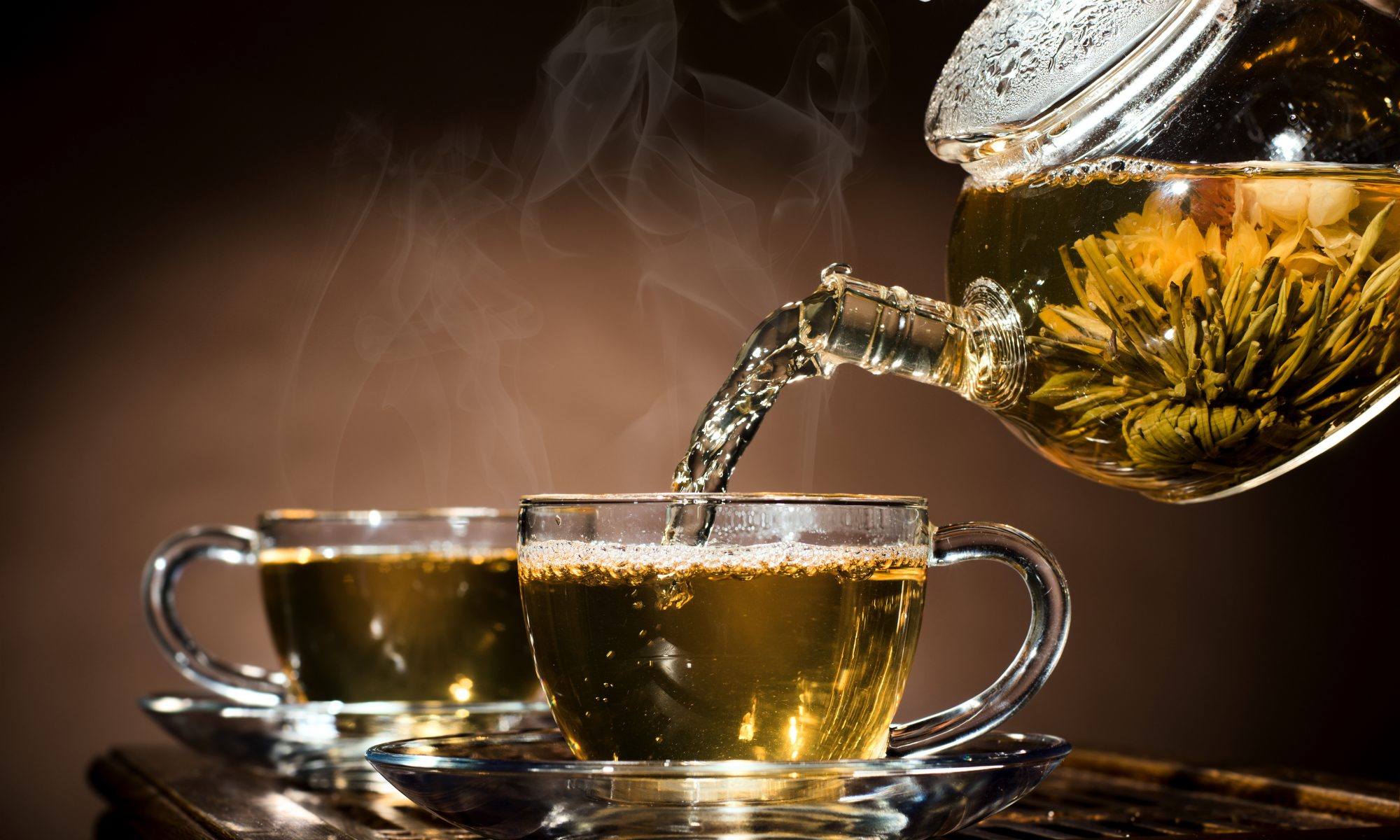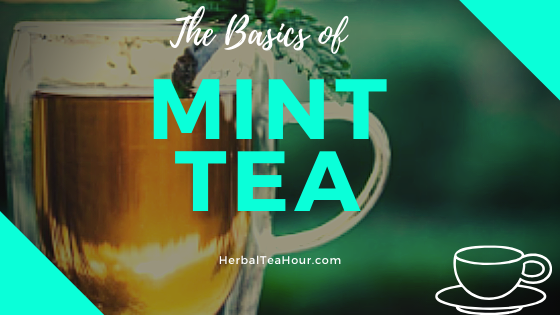BASIC MINT TEA: INTRO
Skip Ahead To:
The mint plant is truly famous in the herbal industry. This plant comes in various species and results in various types of products (tea and otherwise). Did you know that the mint plant is also the main ingredient behind the basic mint tea you enjoy today?
Basic Mint Tea: Overview

The various species and hybrids of species of the mint plant might make choosing the best mint tea a bit difficult – we are here to help! In this article, we’ll tell you some interesting things about the mint plant as well as basic mint tea. We’ll also give you a simple recipe in preparing a basic mint tea.
We will also pinpoint the most important things to keep an eye out for when looking to purchase a high quality mint tea. We then provide two mint tea products that are truly top notch. I relay some of my own experiences with each basic mint tea, and even provide some of the pros and cons. Looking forward to it? Let’s take the first step!
Mint Tea – Learning the Basics
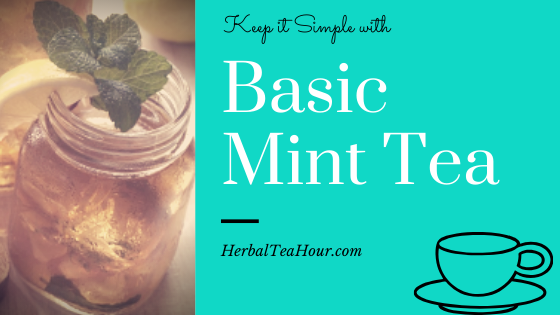
Please note: This post contains affiliate links. An affiliate link means that we may earn advertising/referral fees if you make a purchase through our links.
Mint is divided into about 24 species. Did you know that another name for the mint plant is mentha? Within these 24 species, a lot of hybrid formations take place! That is one of the reasons that basic mint tea has become so popular – versatility!
Apple mint and spearmint are just some of the classifications of the mint plant. Even the famous peppermint tea comes from this plant. Amazing right?
A basic mint tea is not native to just one continent. Several species can be found in five continents across the globe. Even with a short growing season, this is a particularly hardy plant, and its no surprise that its popularity has extended to far and wide. The mint plant, and thus basic mint tea, truly has a global outreach!
Typically, the mint plant is grown or found in wet environments where it grows to approximately 3 feet in height, featuring a rich green color. Another kind of herbal tea with a similar growing environment is dandelion tea (you can learn how to make tea with dandelion roots here)!
From allergies to cosmetics, the utility of the mint plant is about as versatile as its variety of tastes! Of course, our favorite use of the mint plant is in the preparation of one of our favorite types of herbal tea – the basic mint tea!! There aren’t even significant side effects stemming from mint tea consumption (like there can be in other herbal teas (learn about hibiscus tea side effects)).
Let’s look at a couple very simple recipes on how to prepare a palate pleasing cup of basic mint tea!!!
Basic Mint Tea: Some Simple Recipes

Please Note: As an Amazon Associate, I earn from qualifying purchases.
Hot Fresh Mint Tea
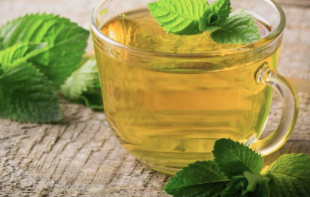
Tip: Remember that mint is pretty hardy. So while the various species each have the right temperature for preparing them, they can withstand heated (boiling) water being directly poured onto them.
There are several ways you can prepare a basic mint tea. Below, we’ve provided one recipe for the hot fresh mint tea and one for the iced mint tea!
Simple List of Ingredients:
- Water (2 cups)
- Fresh mint (quantity varies depending upon desired mint taste)
- Lemon
- Sweeteners
Keep in mind that sweeteners and lemon are optional and can be discarded. However, we like to add these elements as it seems to really bring out the minty taste in the tea!
Easy to Follow Instructions:
Step One. The first step will be to boil your water. The temperature and amount of time needed to bring the water to a boil will depend upon, among other things, how many feet above sea level you are located. Try not to boil more water than you need!!
Step Two. Get your ingredients ready. Depending on your choice, you might have fresh mint leaves plucked or you might have purchased them. Many HTH readers have their own mint gardens! Whether self grown or store bought, you need to rinse your leaves to make sure they are clean and free from residue or pesticide!
Cutting the leaves brings out the sweet-smelling aroma which translates to stronger flavor. The more you cut the leaves, the greater the aroma released. This is due to the release of the oils from the inside of the tea leaf!
Step Three. Pour your cut mint leaves into a teapot that can hold loose leaves. Some people might decide to use a mug instead of a teapot – it all depends on whether you are brewing for yourself, or a bunch of friends!
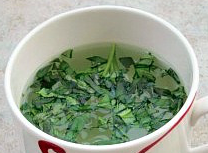
Step Four. Pour your boiling water over the leaves. Please be careful and wear protective gloves and other items while working with boiling water! Remember, “hot” water doesn’t work, you need to have brought the water to a boil!
Step Five. Once this has been done, it’s time to steep the tea. This should take between 3-10 minutes to perform. A longer steeping time can result in a stronger flavor, with a lower steeping time resulting in only a hint of minty goodness! The taste and smell can help you track it’s level of strength!!
Step Six. Use a strainer to separate the tea from the leaves. After all, you don’t want to be left with a mouth full of tea leaves! At this point, you might want to add optional ingredients such as sweeteners and lemon. We like to go a little heavier on the sweetener and a little lighter on the lemon. However, the possibilities to experiment are endless!
Your tea is ready!
Iced Fresh Mint Tea

Simple List of Ingredients
- Sprigs of fresh mint
- Water (9 cups)
- Lemon (optional – but tasty!)
- Sugar (150 grams)
Easy to Follow Instructions
The first steps in this particular recipe are similar to the ones you followed while making the hot fresh mint tea (shown above). Here are the steps to follow after that has been completed:
Step One. Allow your tea to cool. You can do this by placing it in the refrigerator or by letting it cool naturally to room temperature over time. If you plan on adding sweeteners (sugar, honey, etc), we recommend you do that before going any further.
Tip: The fastest way to get your tea to cool down will be to refrigerate it.
Step Two. Once it has cooled down, strain your tea from the leaves using a strainer. This will keep the tea leaves separate from your tea! Make sure you keep your environment clean by discarding the mint leaves you have used. Some HTH readers add the used tea leaves to their compost piles. What an environmentally responsible approach!!
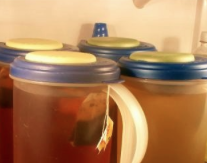
Step Three. Serve your tea. The glass or teapot that you intend to use should be filled with ice. You can spice things up adding a sliced cucumber to go with it. Many HTH readers have also experimented with “infusing” the ices mint tea with other fruits (we mostly hear of oranges, lemons and apples). You can do this the old fashioned way by slicing up these fruits and letting them sit in the tea once served!!
Your tea is ready!
We’re thrilled that you have mastered our simple recipe on making a delicious cup of basic mint tea (whether hot or cold). Now, let’s talk about something as equally important as preparing the mint tea – how to find the best kind of mint tea to work with)!
If you liked these easy to follow tea recipes, you might be interested in our Anise Seed Tea Recipe! Our favorite, at least as of the time of writing this article, is our special dandelion leaf tea recipe – easy to use and tastes great!
Basic Mint Tea: How to Find the Best

Finding the right mint tea is important. It impacts the quality of the leaves as well as the final product itself. It also affects the flavor and, ultimately, what kind of value you are getting for your money.
That being said, let’s take a look at some important factors that you’ll need to consider when evaluating one mint tea against another;
Sustainable Farming Practices
The quality of mint leaves is best preserved and maintained through sustainable farming practices and environmentally responsibility. This means that the mint leaves should be grown without any significant interference from humans – better to rely on good ole’ Mother Nature!
When looking for a top quality mint tea, especially if you are just looking to create a basic mint tea, knowing the location of the farm and what is used during production is important. Make sure that the mint leaves or products you purchase are cultivated using sustainable farming. The environment will thank you and your tastebuds will too!
Necessary Approvals
Like most industries today, the herbal tea industry is regulated by several bodies. The cultivation, farming and production of mint (and thus mint leaves) will have to pass these bodies before they obtain their stamp of approval.
Some examples of a valuable “seal of approval” are kosher certifications as well as being non-GMO verified. There are others, of course, but a low quality mint tea will have difficulty obtaining any accreditation whatsoever.
Quantity Helps Quality
While you should have an eye out for top quality mint products, quantity also doesn’t hurt. After all, the more mint tea – the better! Look out for products that offer a good option with the size or number of mint teabags. A good number of mint leaves or bags when combined with a lengthy expiration date can be a lifesaver. Remember, it all depends on how much you consume and how many you are brewing for!
These same important features are necessary when evaluating other herbal teas. They will be helpful when you are researching where to buy dandelion tea, for instance.
Basic Mint Tea: Buy the Best
Need a little help getting the right product? Want to rely on someone else who has already done the research and the taste testing? We are happy to make a couple recommendations for you! Here are some of the top mint tea products out there, each of which would be a fantastic choice for a cup of basic mint tea;
This particular brand has been around since 1945. Their plantain mint tea is mixed with spearmint and is available in almost every flavor you can think of (remember, versatility is what makes basic mint tea so popular).
It comes in foils, each wrapped separately from another to prolong their freshness and aroma. Preservation of freshness is key, and the separate wrapping is a great way to accomplish this goal. The total number of teabags in 6 packs is 120.
This gives you quantity as well as quality – just like our tip from above! This product is also kosher certified as well as non-GMO verified. Remember the importance of obtaining a seal of approval from a quality organization? With a great taste and a good track record, this product clearly has a lot to offer.
My Experience
It’s quite delicious, to say the least. I especially like the vanilla flavor as it keeps things interesting for me. One of the things you are bound to notice is the energy that it gives. Is this medically related, or just because of the tremendous boost it gives me mentally? Well, I don’t know, but I do know that this is a fantastic choice in the mornings!
It completely fueled my body and made me ready to face work once again. I’ve drawn up some of the pros and cons you can expect when using this product.
Pros
- Kosher certified
- Fuels the body
- Large quantity
- Good price
- Come with a lot of flavors
- Manufacturer’s proven track record
Cons
- I didn’t especially enjoy their raspberry flavor
This is another great basic mint tea offering that combines mint and fruits to produce a unique product. Remember how we discussed the infusion process above? If you have always wondered how combining lemon and mint tastes, then this is the tea for you.
It comes in 4 packs containing 15 sachets each. This gives you a grand total of 60 bags. A pretty good quantity for the average tea drinker. Remember to not “overbuy”, as doing so puts you at risk for spoilage!
One thing that impresses me about this product is the sustainable farming practices upheld by the manufacturer. It really says a lot about the manufacturer’s integrity. This ensures that there are no additives in this the tea – they rely on Mother Nature! The product also meets several certifications by regulatory bodies. Kosher and USDAorganic are just some of them. This makes it safe for use and great tasting!
My Experience
I have always been a fan of spearmint. So I absolutely loved this product. It also has some taste of lemon to go with it. Remember, you can go light on the sweeteners is you want, but honey is a great additive here as well!
I found this tea calming and a bit soothing. It’s the perfect tea if you are looking to calm your nerves and take a break from your hectic schedule. I found myself consuming in largely in the evenings for this exact reason. It’s also a great option if you are looking to break loose from caffeine (which can be a pretty tricky habit to break).
Here are some pros and cons I compiled after drinking a significant amount of this particular mint tea:
Pros
- Soothing feeling
- Certified
- Affordable
- Nice blend of fruits and mint
- Ethically sourced
Cons
- It comes with just 60 sachets.
CONCLUSION

We hope this HTH has served you as a useful guide in teaching you everything you need to know about a basic mint tea. No one can deny the amazing taste of a basic mint tea – this is why it has become so popular all over the globe. Be sure to ask us if you have any questions or if you encounter any difficult when trying to find a particular brand!
Comments
What do you think? Have you ever tried a basic mint tea? Pretty refreshing stuff huh? How did you make it? Did you follow any of the recipes that we included in this article? How did it turn out? Have you discovered any different recipes that you’d like to share with this group? We’d love to hear from you! Please share your story with us! We read and reply to every comment!!
